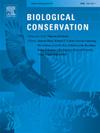伞形,拱顶石,还是旗舰?识别有效替代物种的综合框架
IF 4.4
1区 环境科学与生态学
Q1 BIODIVERSITY CONSERVATION
引用次数: 0
摘要
全球生物多样性危机需要有针对性的保护战略,在资源有限的情况下实现影响最大化。替代物种方法,特别是使用保护伞、基石和旗舰物种,为保护规划提供了实际的目标,可能间接有益于生态系统。然而,选择目标物种往往受到概念模糊和方法不一致的阻碍。为了应对这些挑战,我们提出了一个综合框架,通过结合大数据的多标准决策分析(MCDA)系统地识别有效的替代物种。我们的框架使用三个指数来量化每个物种的保护潜力:保护伞指数、Keystone指数和旗舰指数。保护伞指数利用栖息地面积(Area of habitat, AOH)数据评估栖息地重叠程度,Keystone指数通过捕食者-猎物关系的网络分析计算得出,旗舰指数通过谷歌Trends和百度index分析公共利益。利用多属性效用理论(Multi-Attribute Utility Theory, MAUT)模型将这些指标整合成一个综合效用指数,并进行敏感性分析以评估物种排名的稳健性。我们将这一框架应用于青藏高原三江源国家公园。结果表明,雪豹(Panthera uncia)是哺乳动物中最有效的替代物种,在Flagship和Keystone指数中均排名第一,在Umbrella指数中排名第十,在综合有效性指数中排名第一。这种数据驱动的、透明的方法提高了替代物种选择的客观性,有望在全球范围内开展更具战略性和影响力的生物多样性保护工作。本文章由计算机程序翻译,如有差异,请以英文原文为准。

Umbrella, keystone, or flagship? An integrated framework for identifying effective surrogate species
The global biodiversity crisis demands targeted conservation strategies that maximize impact despite limited resources. Surrogate species approaches, particularly using umbrella, keystone, and flagship species, offer practical targets for conservation planning that may indirectly benefit ecosystems. However, selecting target species is often hindered by conceptual ambiguities and inconsistent methodologies. To address these challenges, we present an integrative framework that systematically identifies effective surrogate species through Multi-Criteria Decision Analysis (MCDA) combined with big data. Our framework quantifies each species' conservation potential using three indices: an Umbrella index, a Keystone index, and a Flagship index. The Umbrella index assesses habitat overlap using Area of Habitat (AOH) data, the Keystone index is calculated through a network analysis of predator-prey relationships, and the Flagship index analyzes public interest via Google Trends and Baidu Index. These indices are integrated into a composite Effectiveness index using the Multi-Attribute Utility Theory (MAUT) model, with sensitivity analysis to evaluate the robustness of species rankings. We applied this framework to Three-River-Source National Park in the Qinghai-Tibetan Plateau. Our results identified the snow leopard (Panthera uncia) as the most effective surrogate species among mammals, ranking first in both the Flagship and Keystone indices, and tenth in the Umbrella index, leading to its top position in the composite Effectiveness index. This data-driven, transparent approach enhances objectivity in surrogate species selection, promising more strategic and impactful biodiversity conservation efforts worldwide.
求助全文
通过发布文献求助,成功后即可免费获取论文全文。
去求助
来源期刊

Biological Conservation
环境科学-环境科学
CiteScore
10.20
自引率
3.40%
发文量
295
审稿时长
61 days
期刊介绍:
Biological Conservation is an international leading journal in the discipline of conservation biology. The journal publishes articles spanning a diverse range of fields that contribute to the biological, sociological, and economic dimensions of conservation and natural resource management. The primary aim of Biological Conservation is the publication of high-quality papers that advance the science and practice of conservation, or which demonstrate the application of conservation principles for natural resource management and policy. Therefore it will be of interest to a broad international readership.
 求助内容:
求助内容: 应助结果提醒方式:
应助结果提醒方式:


